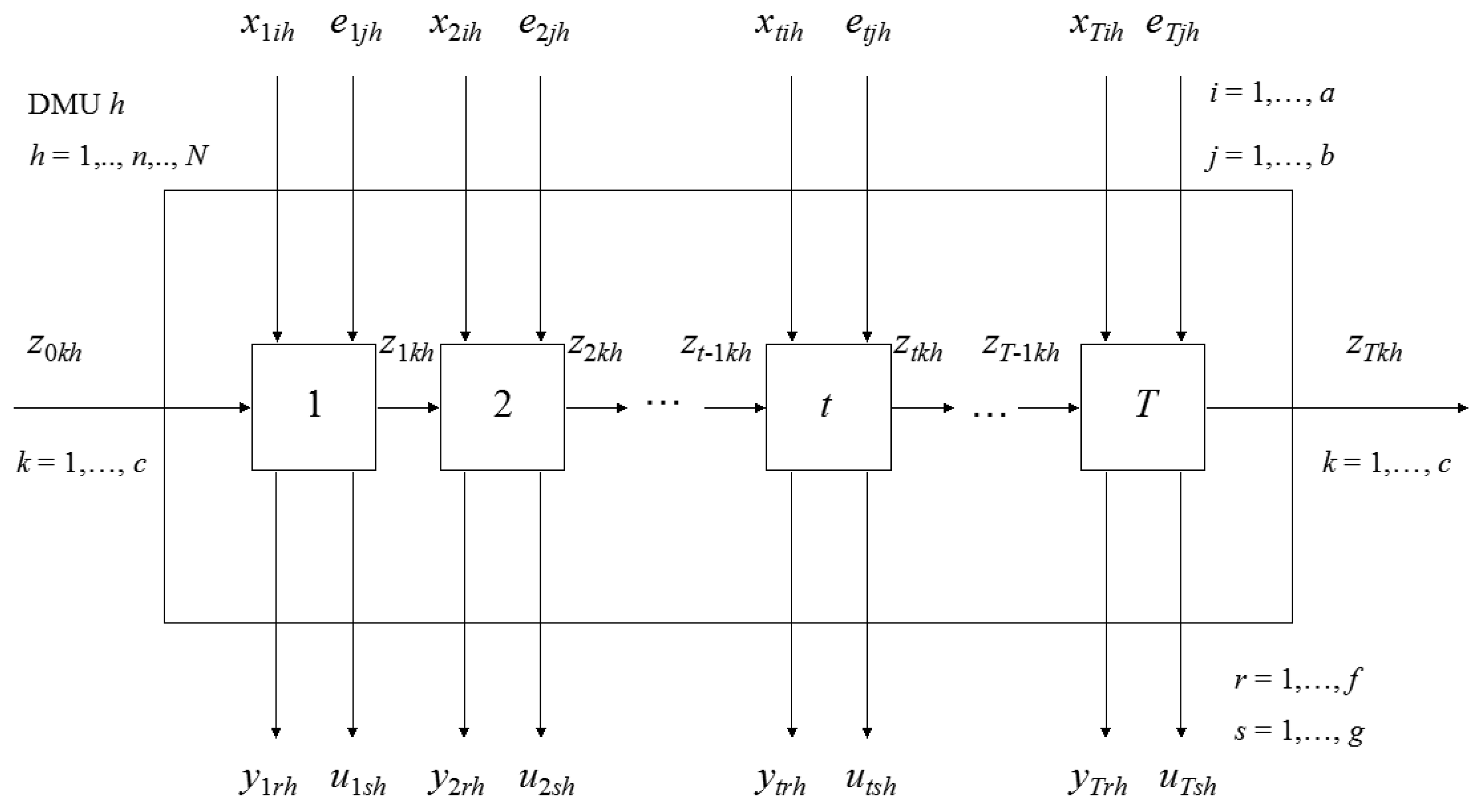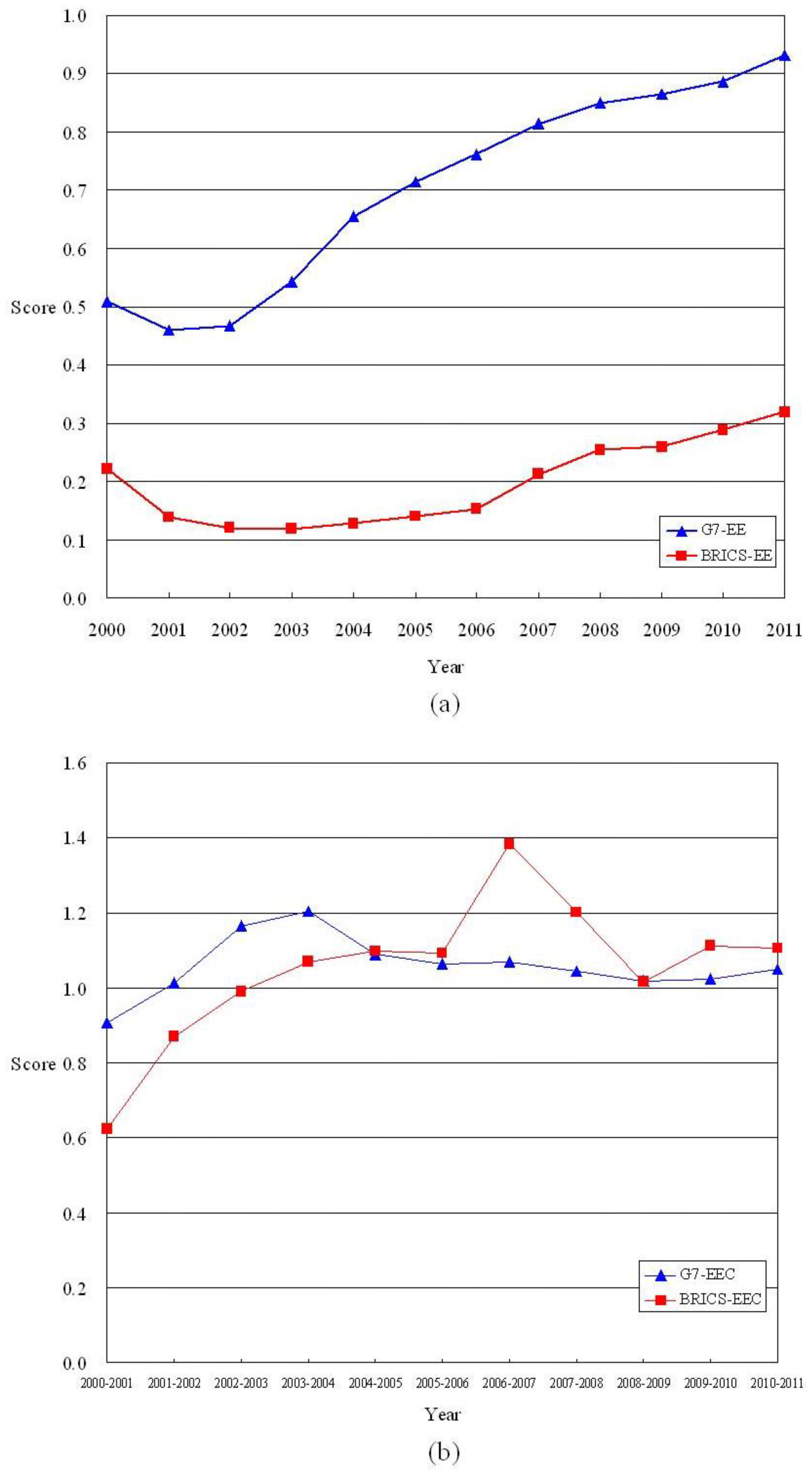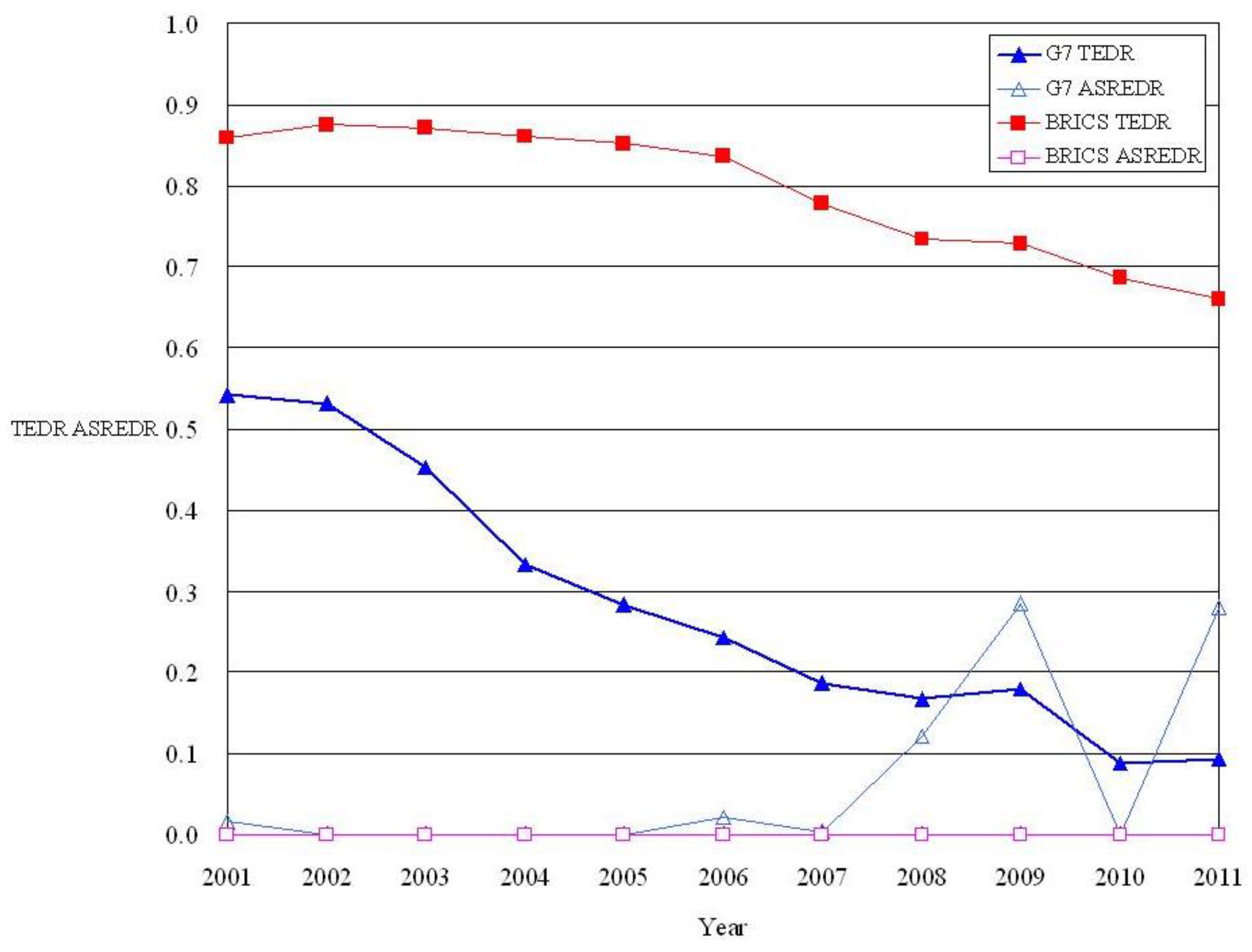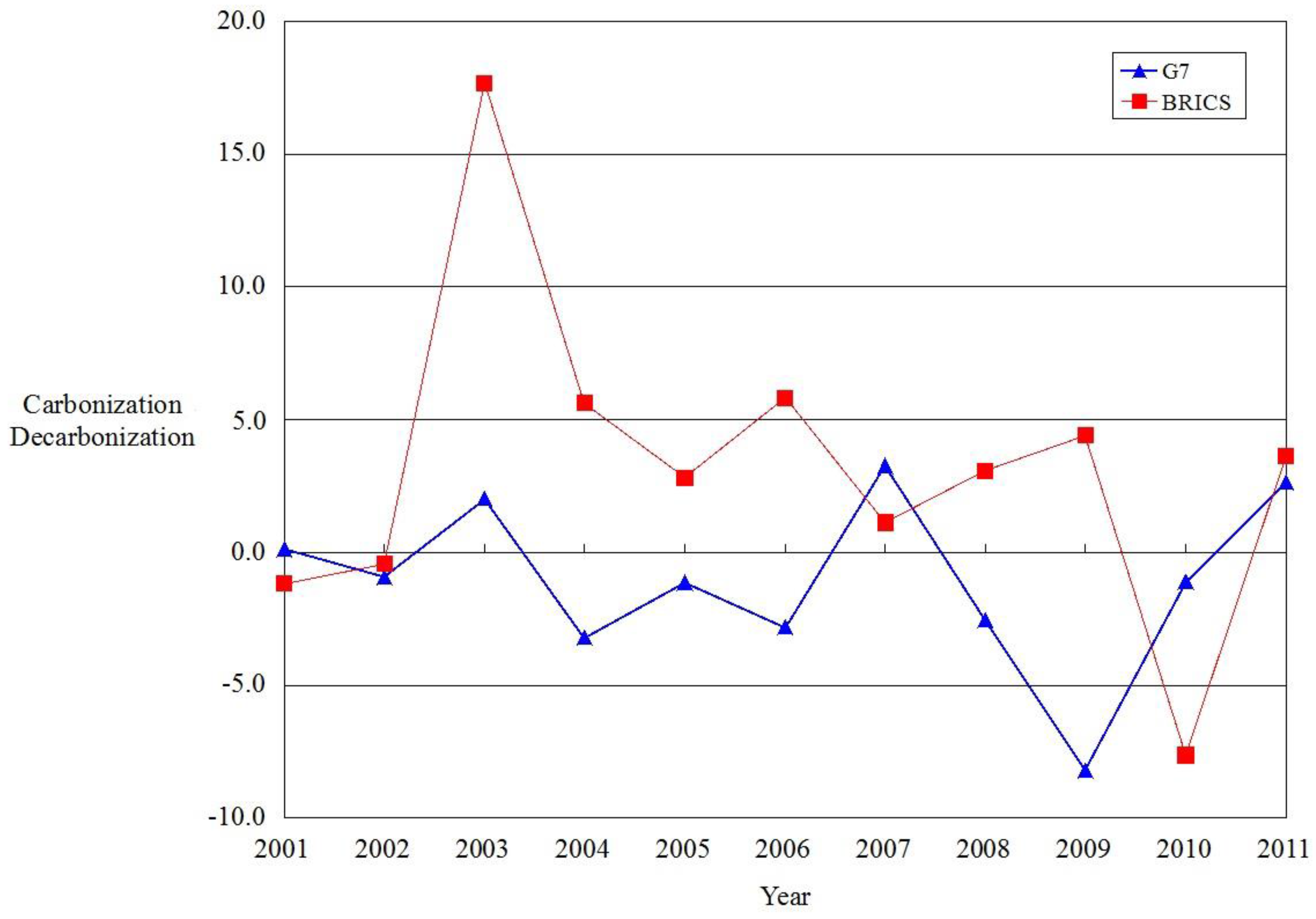Progressive Time-Weighted Dynamic Energy Efficiency, Energy Decoupling Rate, and Decarbonization: An Empirical Study on G7 and BRICS
Abstract
:1. Introduction
2. Methodology
2.1. Dynamic Energy Efficiency Model
2.2. Progressive Time-Weighted Dynamic Energy Efficiency Model
2.3. Group Energy Efficiency and Decoupling Rate for Energy Use
3. Empirical Analysis
3.1. Data Description
3.2. Energy Efficiency and Energy Efficiency Change
3.3. Group Energy Efficiency and Group Energy Efficiency Change
3.4. Energy Decoupling Rate and the Achievement Standard Ratio of the Energy Decoupling Rate
3.5. Decarbonization or Carbonization for the Two Groups of Countries
4. Policy Implication
5. Conclusions
Author Contributions
Conflicts of Interest
References
- Douglas, J. India Claims Its Emissions Cause No Harm to World’s Atmosphere. Available online: http://www.naturalnews.com/021335_global_warming_India.html (accessed on 21 December 2006).
- Boyd, G.A.; Pang, J.X. Estimating the linkage between energy efficiency and productivity. Energy Policy 2000, 28, 289–296. [Google Scholar] [CrossRef]
- Hu, J.L.; Wang, S.C. Total-factor energy efficiency of regions in China. Energy Policy 2006, 34, 3206–3217. [Google Scholar] [CrossRef]
- Han, Z.Y.; Fan, Y.; Jiao, J.L.; Yan, J.S.; Wei, Y.M. Energy structure, marginal efficiency and substitution rate: An empirical study of China. Energy 2007, 32, 935–942. [Google Scholar] [CrossRef]
- Hu, J.L.; Kao, C.H. Efficient energy-saving targets for APEC economies. Energy Policy 2007, 35, 373–382. [Google Scholar] [CrossRef]
- Zhang, X.P.; Cheng, X.M.; Yuan, J.H.; Gao, X.J. Total-factor energy efficiency in developing countries. Energy Policy 2011, 39, 644–650. [Google Scholar] [CrossRef]
- Wei, Y.M.; Liao, H.; Fan, Y. An empirical analysis of energy efficiency in China’s iron and steel sector. Energy 2007, 32, 2262–2270. [Google Scholar] [CrossRef]
- Munkherjee, K. Measuring energy efficiency in the context of an emerging economy: The case of Indian manufacturing. Eur. J. Oper. Res. 2010, 201, 933–941. [Google Scholar] [CrossRef]
- Honma, S.; Hu, J.L. Industry-level total-factor energy efficiency in developed countries: A Japan-centered analysis. Appl. Energy 2014, 119, 67–78. [Google Scholar] [CrossRef]
- Honma, S.; Hu, J.L. Total-factor energy efficiency of regions in Japan. Energy Policy 2008, 36, 821–833. [Google Scholar] [CrossRef]
- Färe, R.; Grosskopf, S. Intertemporal Production Frontiers: With Dynamic DEA; Kluwer Academic Publishers: Boston, MA, USA, 1996. [Google Scholar]
- Caves, D.W.; Christensen, L.R.; Diewert, W.E. The economic theory of index numbers and the measurement of input, output, and productivity. Econometrica 1982, 50, 1393–1414. [Google Scholar] [CrossRef]
- Färe, R.; Grosskopf, S.; Norris, M.; Zhang, Z. Productivity growth, technical progress, and efficiency change in industrialized countries. Am. Econ. Rev. 1994, 84, 66–83. [Google Scholar]
- Honma, S.; Hu, J.L. Total-factor energy productivity growth of regions in Japan. Energy Policy 2009, 37, 3941–3950. [Google Scholar] [CrossRef]
- Chang, T.P.; Hu, J.L. Total-factor energy productivity growth, technical progress, and efficiency change: An empirical study of China. Appl. Energy 2010, 87, 3262–3270. [Google Scholar] [CrossRef]
- Chang, M.C. Applying the energy productivity index that considers maximized energy reduction on SADC (Southern Africa Development Community) members. Energy 2016, 95, 313–323. [Google Scholar] [CrossRef]
- Tone, K.; Tsutsui, M. Dynamic DEA: A slacks-based measure approach. Omega 2010, 38, 145–156. [Google Scholar] [CrossRef]
- Kao, C. Dynamic data envelopment analysis: A relational analysis. Eur. J. Oper. Res. 2013, 227, 325–330. [Google Scholar] [CrossRef]
- Farrell, M.J. The measurement of productive efficiency. J. R. Stat. Soc. Ser. A (Gen.) 1957, 120, 253–290. [Google Scholar] [CrossRef]
- Charnes, A.; Cooper, W.W.; Rhodes, E. Measuring the efficiency of decision making units. Eur. J. Oper. Res. 1978, 2, 429–444. [Google Scholar] [CrossRef]
- Førsund, F.R. Weight restrictions in DEA: Misplaced emphasis? J. Prod. Anal. 2013, 40, 271–283. [Google Scholar] [CrossRef]
- Allen, R.; Athanassopoulos, A.; Dyson, R.G.; Thanassoulis, E. Weights restrictions and value judgements in data envelopment analysis: Evolution, development and future directions. Ann. Oper. Res. 1997, 73, 13–34. [Google Scholar] [CrossRef]
- Podinovski, V.V. Side effects of absolute weight bounds in DEA models. Eur. J. Oper. Res. 1999, 115, 583–595. [Google Scholar] [CrossRef]
- Oikonomou, N.; Tountas, Y.; Mariolis, A.; Souliotis, K.; Athanasakis, K.; Kyriopoulos, J. Measuring the efficiency of the Greek rural primary health care using a restricted DEA model; the case of southern and western Greece. Health Care Manag. Sci. 2015. [Google Scholar] [CrossRef] [PubMed]
- Podinovski, V.V.; Bouzdine-Chameeva, T. On single-stage DEA models with weight restrictions. Eur. J. Oper. Res. 2016, 248, 1044–1050. [Google Scholar] [CrossRef]
- Dyson, R.G.; Thanassoulis, E. Reducing weight flexibility in data envelopment analysis. J. Oper. Res. Soc. 1988, 39, 563–576. [Google Scholar] [CrossRef]
- Wong, Y.H.; Beasley, J.E. Restricting weight flexibility in data envelopment analysis. J. Oper. Res. Soc. 1990, 41, 829–835. [Google Scholar] [CrossRef]
- Thompson, R.G.; Langemeier, L.N.; Lee, C.T.; Lee, E.; Thrall, R.M. The role of multiplier bounds in efficiency analysis with application to Kansas farming. J. Econom. 1990, 46, 93–108. [Google Scholar] [CrossRef]
- Cook, W.D.; Zhu, J. CAR-DEA: Context-dependent assurance regions in DEA. Oper. Res. 2008, 56, 69–78. [Google Scholar] [CrossRef]
- Guo, X.D.; Zhu, L.; Fan, Y.; Xie, B.C. Evaluation of potential reductions in carbon emissions in Chinese provinces based on environmental DEA. Energy Policy 2011, 39, 2352–2360. [Google Scholar] [CrossRef]
- Zhou, P.; Ang, B.W. Linear programming models for measuring economy-wide energy efficiency performance. Energy Policy 2008, 38, 2911–2916. [Google Scholar] [CrossRef]
- Mandal, S.K. Do undesirable output and environmental regulation matter in energy efficiency analysis? Evidence from Indian cement industry. Energy Policy 2010, 38, 6076–6083. [Google Scholar] [CrossRef]
- Song, M.L.; Zhang, L.L.; Liu, W.; Fisher, R. Bootstrap-DEA analysis of BRICS’ energy efficiency based on small sample data. Appl. Energy 2013, 112, 1049–1055. [Google Scholar] [CrossRef]
- Wu, F.; Fan, L.W.; Zhou, P.; Zhou, D.Q. Industrial energy efficiency with CO2 emissions in China: A nonparametric analysis. Energy Policy 2012, 49, 164–172. [Google Scholar] [CrossRef]
- Zhou, P.; Ang, B.W.; Zhou, D.Q. Measuring economy-wide energy efficiency performance: A parametric frontier approach. Appl. Energy 2012, 90, 196–200. [Google Scholar] [CrossRef]
- Coelli, T.J.; Prasada Rao, D.S.; O’Donnell, C.J.; Battese, G.E. An Introduction to Efficiency and Productivity Analysis, 2nd ed.; Kluwer Academic Publishers: Boston, MA, USA, 2005. [Google Scholar]
- Wang, Z.; Feng, C.; Zhang, B. An empirical analysis of China’s energy efficiency from both static and dynamic perspectives. Energy 2014, 74, 322–330. [Google Scholar] [CrossRef]
- Kumar, M.; Vincent, C. Benchmarking Indian banks using DEA in post-reform period: A progressive time-weighted mean approach. Serv. Ind. J. 2011, 31, 2455–2485. [Google Scholar] [CrossRef]
- Organization for Economic Co-operation and Development (OECD). Indicators to Measure Decoupling of Environmental Pressure from Economic Growth; OECD: Paris, France, 2002. [Google Scholar]
- Mudgal, S.; Fischer-Kowalski, M.; Krausmann, F.; Chenot, B.; Lockwood, S.; Mitsios, A.; Schaffartzik, A.; Eisenmenger, N.; Cachia, F.; Steinberger, J.; et al. Preparatory Study for the Review of the Thematic Strategy on the Sustainable Use of Natural Resources; Contract 07.0307/2009/545482/ETU/G2; European Commission, DG Environment: Paris, France, 2010. [Google Scholar]
- Choi, Y.; Zhang, N.; Zhou, P. Efficiency and abatement costs of energy-related CO2 emissions in China: A slacks-based efficiency measure. Appl. Energy 2012, 98, 198–208. [Google Scholar] [CrossRef]
- Chang, M.C. Room for improvement in low carbon economies of G7 and BRICS countries based on the analysis of energy efficiency and environmental Kuznets curves. J. Clean Prod. 2015, 99, 140–151. [Google Scholar] [CrossRef]
- De Castro Camioto, F.; Moralles, H.F.; Mariano, E.B.; do Nascimento Rebelatto, D.A. Energy efficiency analysis of G7 and BRICS considering total-factor structure. J. Clean Prod. 2016, 122, 67–77. [Google Scholar] [CrossRef]
- Mielnik, O.; Goldemberg, J. Communication: The evolution of the “carbonization index” in developing countries. Energy Policy 1999, 27, 307–308. [Google Scholar] [CrossRef]
- Freitas, I.M.B.; Dantas, E.; Iizuka, M. The Kyoto mechanisms and the diffusion of renewable energy technologies in the BRICS. Energy Policy 2012, 42, 118–128. [Google Scholar] [CrossRef]
- Dechezleprêtre, A.; Glachant, M.; Ménière, Y. The Clean Development Mechanism and the international diffusion of technologies: An empirical study. Energy Policy 2008, 36, 1273–1283. [Google Scholar] [CrossRef]




| Input | Output | ||||
|---|---|---|---|---|---|
| Real Capital Formation (Million US$) | Labors (Person) | Energy Use (Kt of Oil Equivalent) | Real GDP (Million US$) | CO2 (Kt) | |
| Average | 734,549.262 | 182,550,885.166 | 613,141,077.340 | 3,111,505.977 | 1,595,256.679 |
| Max | 3,497,032.681 | 929,306,700.734 | 2,746,916,231.000 | 15,225,673.499 | 9,019,518.215 |
| Min | 29,125.906 | 18,113,710.997 | 109,056,448.000 | 178,928.298 | 320,173.104 |
| St. Dev. | 836,267.091 | 277,526,531.327 | 676,387,424.727 | 3,595,787.148 | 1,960,428.391 |
| Country Name | 2000 | 2001 | 2002 | 2003 | 2004 | 2005 | 2006 | 2007 | 2008 | 2009 | 2010 | 2011 | Average |
|---|---|---|---|---|---|---|---|---|---|---|---|---|---|
| Canada | 0.495 | 0.294 | 0.258 | 0.263 | 0.283 | 0.309 | 0.337 | 0.375 | 0.388 | 0.365 | 0.418 | 0.456 | 0.353 |
| France | 0.803 | 0.487 | 0.464 | 0.525 | 0.572 | 0.577 | 0.605 | 0.688 | 0.730 | 0.702 | 0.665 | 0.756 | 0.631 |
| Germany | 0.561 | 0.446 | 0.462 | 0.545 | 0.595 | 0.598 | 0.618 | 0.772 | 0.838 | 0.815 | 0.777 | 0.893 | 0.660 |
| Italy | 1.000 | 0.638 | 0.608 | 0.675 | 0.733 | 0.728 | 0.753 | 0.847 | 1.000 | 0.877 | 0.811 | 0.887 | 0.796 |
| Japan | 0.629 | 0.531 | 0.508 | 0.549 | 0.607 | 0.627 | 0.612 | 0.629 | 0.730 | 0.811 | 0.854 | 1.000 | 0.674 |
| United Kingdom | 0.840 | 0.610 | 0.631 | 0.688 | 0.795 | 0.812 | 0.861 | 1.000 | 0.950 | 0.800 | 0.816 | 0.925 | 0.811 |
| United States | 0.373 | 0.435 | 0.455 | 0.553 | 0.709 | 0.804 | 0.876 | 0.905 | 0.924 | 0.965 | 1.000 | 1.000 | 0.750 |
| Brazil | 0.992 | 0.472 | 0.335 | 0.294 | 0.296 | 0.350 | 0.397 | 0.453 | 0.490 | 0.474 | 0.543 | 0.629 | 0.477 |
| China | 0.092 | 0.091 | 0.094 | 0.097 | 0.103 | 0.113 | 0.125 | 0.200 | 0.273 | 0.305 | 0.334 | 0.373 | 0.183 |
| India | 0.188 | 0.138 | 0.127 | 0.138 | 0.145 | 0.153 | 0.155 | 0.194 | 0.174 | 0.163 | 0.179 | 0.171 | 0.160 |
| Russian Federation | 0.124 | 0.094 | 0.087 | 0.090 | 0.110 | 0.124 | 0.145 | 0.187 | 0.212 | 0.145 | 0.162 | 0.181 | 0.138 |
| South Africa | 1.000 | 0.330 | 0.205 | 0.189 | 0.191 | 0.200 | 0.197 | 0.185 | 0.147 | 0.145 | 0.175 | 0.184 | 0.262 |
| Country Name | 2000–2001 | 2001–2002 | 2002–2003 | 2003–2004 | 2004–2005 | 2005–2006 | 2006–2007 | 2007–2008 | 2008–2009 | 2009–2010 | 2010–2011 |
|---|---|---|---|---|---|---|---|---|---|---|---|
| Canada | 0.593 | 0.879 | 1.021 | 1.076 | 1.091 | 1.091 | 1.111 | 1.036 | 0.940 | 1.145 | 1.092 |
| France | 0.606 | 0.953 | 1.131 | 1.090 | 1.009 | 1.048 | 1.138 | 1.060 | 0.961 | 0.947 | 1.137 |
| Germany | 0.795 | 1.035 | 1.181 | 1.092 | 1.004 | 1.033 | 1.249 | 1.086 | 0.972 | 0.953 | 1.150 |
| Italy | 0.638 | 0.954 | 1.109 | 1.087 | 0.993 | 1.035 | 1.124 | 1.181 | 0.877 | 0.925 | 1.094 |
| Japan | 0.845 | 0.956 | 1.082 | 1.105 | 1.033 | 0.975 | 1.029 | 1.160 | 1.111 | 1.053 | 1.171 |
| United Kingdom | 0.726 | 1.034 | 1.091 | 1.156 | 1.022 | 1.060 | 1.161 | 0.950 | 0.843 | 1.020 | 1.133 |
| United States | 1.165 | 1.048 | 1.213 | 1.282 | 1.135 | 1.089 | 1.033 | 1.021 | 1.044 | 1.037 | 1.000 |
| Brazil | 0.476 | 0.710 | 0.877 | 1.009 | 1.179 | 1.136 | 1.140 | 1.083 | 0.967 | 1.145 | 1.159 |
| China | 0.994 | 1.032 | 1.030 | 1.068 | 1.094 | 1.104 | 1.604 | 1.365 | 1.116 | 1.094 | 1.116 |
| India | 0.733 | 0.924 | 1.080 | 1.051 | 1.058 | 1.012 | 1.251 | 0.897 | 0.938 | 1.097 | 0.959 |
| Russian Federation | 0.756 | 0.927 | 1.035 | 1.221 | 1.134 | 1.167 | 1.289 | 1.135 | 0.683 | 1.115 | 1.119 |
| South Africa | 0.330 | 0.623 | 0.922 | 1.008 | 1.050 | 0.983 | 0.940 | 0.793 | 0.988 | 1.202 | 1.056 |
| Country Name | Icon | 2001 | 2002 | 2003 | 2004 | 2005 | 2006 | 2007 | 2008 | 2009 | 2010 | 2011 |
|---|---|---|---|---|---|---|---|---|---|---|---|---|
| Canada | EDR | 1% | 0% | 0% | 0% | 0% | 0% | 2% | 0% | 6% | 0% | 0% |
| TEDR | 71% | 74% | 72% | 71% | 69% | 66% | 63% | 61% | 66% | 58% | 54% | |
| ASREDR | 2% | 0% | 0% | 0% | 0% | 0% | 4% | 1% | 9% | 0% | 0% | |
| France | EDR | 0% | 0% | 0% | 0% | 0% | 1% | 1% | 0% | 4% | 0% | 4% |
| TEDR | 50% | 54% | 47% | 42% | 42% | 40% | 32% | 27% | 33% | 31% | 27% | |
| ASREDR | 0% | 0% | 0% | 0% | 0% | 4% | 4% | 0% | 13% | 0% | 13% | |
| Germany | EDR | 0% | 2% | 1% | 0% | 1% | 0% | 5% | 0% | 6% | 0% | 5% |
| TEDR | 54% | 55% | 46% | 40% | 41% | 37% | 27% | 15% | 24% | 18% | 15% | |
| ASREDR | 0% | 4% | 1% | 0% | 2% | 0% | 20% | 0% | 27% | 0% | 33% | |
| Italy | EDR | 0% | 0% | 0% | 0% | 0% | 1% | 1% | 2% | 6% | 0% | 2% |
| TEDR | 36% | 39% | 30% | 26% | 26% | 26% | 16% | 2% | 18% | 16% | 13% | |
| ASREDR | 0% | 0% | 0% | 0% | 0% | 4% | 8% | 100% | 35% | 0% | 14% | |
| Japan | EDR | 2% | 0% | 1% | 0% | 0% | 0% | 1% | 4% | 5% | 0% | 7% |
| TEDR | 48% | 49% | 46% | 37% | 38% | 39% | 38% | 30% | 23% | 10% | 7% | |
| ASREDR | 3% | 0% | 2% | 0% | 1% | 0% | 2% | 13% | 20% | 0% | 100% | |
| United Kingdom | EDR | 0% | 2% | 0% | 0% | 0% | 2% | 4% | 2% | 6% | 0% | 7% |
| TEDR | 39% | 38% | 30% | 21% | 18% | 15% | 4% | 7% | 24% | 16% | 14% | |
| ASREDR | 0% | 6% | 0% | 1% | 0% | 11% | 100% | 27% | 23% | 0% | 51% | |
| United States | EDR | 2% | 0% | 0% | 0% | 0% | 1% | 0% | 3% | 5% | 0% | 1% |
| TEDR | 57% | 54% | 45% | 28% | 19% | 13% | 8% | 10% | 8% | 1% | 1% | |
| ASREDR | 3% | 0% | 0% | 0% | 0% | 7% | 0% | 26% | 59% | 0% | 100% | |
| Brazil | EDR | 0% | 0% | 0% | 0% | 0% | 0% | 0% | 0% | 3% | 0% | 0% |
| TEDR | 52% | 66% | 70% | 69% | 64% | 59% | 52% | 48% | 54% | 40% | 36% | |
| ASREDR | 0% | 0% | 0% | 0% | 0% | 0% | 0% | 0% | 6% | 0% | 0% | |
| China | EDR | 0% | 0% | 0% | 0% | 0% | 0% | 0% | 0% | 0% | 0% | 0% |
| TEDR | 91% | 90% | 89% | 88% | 88% | 86% | 79% | 72% | 67% | 63% | 59% | |
| ASREDR | 0% | 0% | 0% | 0% | 0% | 0% | 0% | 0% | 0% | 0% | 0% | |
| India | EDR | 0% | 0% | 0% | 0% | 0% | 0% | 0% | 0% | 0% | 0% | 0% |
| TEDR | 86% | 87% | 86% | 85% | 84% | 84% | 79% | 82% | 82% | 81% | 82% | |
| ASREDR | 0% | 0% | 0% | 0% | 0% | 0% | 0% | 0% | 0% | 0% | 0% | |
| Russian Federation | EDR | 0% | 0% | 0% | 0% | 0% | 0% | 0% | 0% | 6% | 0% | 0% |
| TEDR | 91% | 91% | 91% | 89% | 87% | 85% | 81% | 78% | 86% | 82% | 81% | |
| ASREDR | 0% | 1% | 0% | 0% | 0% | 0% | 0% | 0% | 7% | 0% | 0% | |
| South Africa | EDR | 0% | 2% | 0% | 0% | 0% | 1% | 0% | 0% | 3% | 0% | 1% |
| TEDR | 66% | 80% | 80% | 79% | 80% | 80% | 80% | 84% | 86% | 83% | 82% | |
| ASREDR | 0% | 3% | 0% | 0% | 0% | 1% | 0% | 0% | 4% | 0% | 1% |
© 2016 by the authors; licensee MDPI, Basel, Switzerland. This article is an open access article distributed under the terms and conditions of the Creative Commons Attribution (CC-BY) license (http://creativecommons.org/licenses/by/4.0/).
Share and Cite
Tu, C.-J.; Chang, M.-C.; Chen, C.-P. Progressive Time-Weighted Dynamic Energy Efficiency, Energy Decoupling Rate, and Decarbonization: An Empirical Study on G7 and BRICS. Sustainability 2016, 8, 928. https://doi.org/10.3390/su8090928
Tu C-J, Chang M-C, Chen C-P. Progressive Time-Weighted Dynamic Energy Efficiency, Energy Decoupling Rate, and Decarbonization: An Empirical Study on G7 and BRICS. Sustainability. 2016; 8(9):928. https://doi.org/10.3390/su8090928
Chicago/Turabian StyleTu, Chia-Jung, Ming-Chung Chang, and Chiang-Ping Chen. 2016. "Progressive Time-Weighted Dynamic Energy Efficiency, Energy Decoupling Rate, and Decarbonization: An Empirical Study on G7 and BRICS" Sustainability 8, no. 9: 928. https://doi.org/10.3390/su8090928
APA StyleTu, C.-J., Chang, M.-C., & Chen, C.-P. (2016). Progressive Time-Weighted Dynamic Energy Efficiency, Energy Decoupling Rate, and Decarbonization: An Empirical Study on G7 and BRICS. Sustainability, 8(9), 928. https://doi.org/10.3390/su8090928




